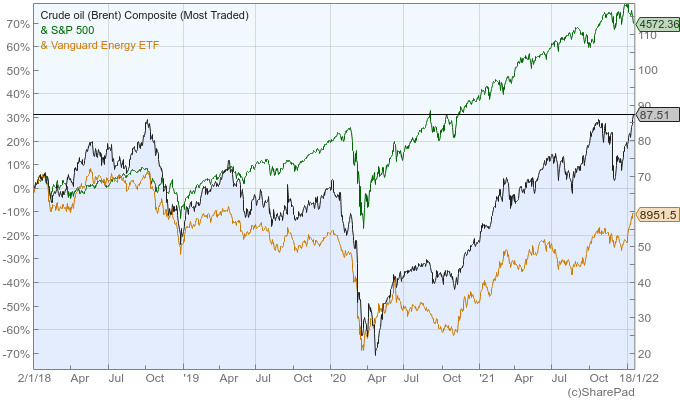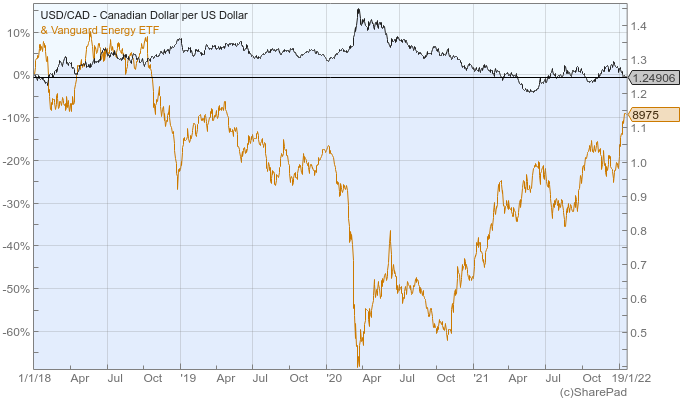A bet against oil prices

In 2014, after experiencing a huge downtrend due to the shale-oil boom in the US, oil prices hit a low at $20. This put many oil explorers out of business around the world, in particular those dedicated to shale-oil explorations.
Several output cuts later, oil prices recovered and hit $85 in October 2018. However, with a growing pressure to seek out cleaner energy and with global growth low, oil prices retreated to $69 by the end of 2019.
Then in early 2020, the pandemic hit the oil market hard. With a huge decrease in demand expected, prices were quickly pushed down to $20 in April that year. Oil futures even turned negative, as the world struggled to find places to stock oil.
Two years later, oil prices are again sitting on multiyear highs, at around $87. Some energy specialists predict prices to surpass $100 this year, due to a mix of constrained supply and increasing demand.
OPEC put in place a plan to increase oil output by 400,000 barrels per day but many of its members have been unable to raise their output to help reach that goal. Only Saudi Arabia has the needed spare capacity to increase output in a significant way, but to date it hasn’t done so. Geopolitical fears, in particular related to the Russian presence at the Ukrainian border, are also affecting prices. The scenario seems very favourable for oil prices.
However, at the current price levels, there are many oil explorations that are profitable and may soon start drilling oil again. This will add to the supply side over time, in particular as prices remain at high levels. At the same time, there are still many risks on the demand side due to the pandemic (which isn’t over yet), due to the growth of cleaner energy and also due to the uncertain consequences of a more hawkish monetary policy stance.
Even though the fundamentals are currently favourable, I believe the demand side of the market doesn’t support these levels and that we’re likely nearing a top for prices as in October 2018. Only time will tell what happens, but after weighting everything, I believe there are currently more downside risks than upside potential.

The uptrend in oil prices has been nothing less than spectacular. Since bottoming at $20 in 2014, oil prices have more than quadrupled, to hit the current level of $87. During this eight-year period, the S&P 500 doubled and oil producers (here proxied by the Vanguard Energy Index Fund (VDE)), tripled in price. The outperformance of energy stocks in general, and oil in particular, is evident. However, given the weaknesses referred to, I would suggest a plan for countering the current uptrend.
One obvious option is to buy an inverse ETF such as the ProShares Short Oil & Gas (NYSEARCA:DDG) or the ProShares UltraShort Oil & Gas (NYSEARCA:DUG). However, I don’t like inverse ETFs because the tracking error of leveraged and inverse ETFs is often huge. Depending on the path taken by prices, it may be the case that the market goes down and an investor holding these funds still loses money. I would therefore rather use spread betting, CFDs or futures than inverse ETFs. Nevertheless, for short periods of time, these inverse ETFs may be useful.
Another option is to directly short a long ETF targeting oil or energy stocks. One possibility would be to sell short the Vanguard Energy Index Fund ETF Shares (NYSEARCA:VDE) or, alternatively, buy put options on this ETF. However, the put options may be too expensive due to current high volatility.
One less obvious option would be to short the Canadian dollar (CAD) against the US dollar (USD). The Canadian dollar is highly tied to oil prices as the Canadian economy heavily depends on oil exports. If oil prices decline, the Canadian dollar would likely follow. There’s another point in favour of this trade, which is related to expected changes in monetary policy. No one wants to precede the Fed in hiking interest rates and the Bank of Canada (BoC) is no exception. A look at the last policy statement from the BoC gives the impression the central bank is unconcerned with inflation risks and still believes the economy needs monetary support:
“The Bank continues to expect CPI inflation to remain elevated in the first half of 2022 and ease back towards 2 percent in the second half of the year.”
“The Governing Council judges that in view of ongoing excess capacity, the economy continues to require considerable monetary policy support. We remain committed to holding the policy interest rate at the effective lower bound until economic slack is absorbed so that the 2 percent inflation target is sustainably achieved.”
With the above in mind, interest rates are expected to rise faster in the US, which supports the case for buying the USD rather than the CAD.

In summary, I believe there are several risks ahead that may impact demand negatively. Additionally, high oil prices are an incentive for increases in the supply of oil. While output increases have been limited so far, they may gather pace as prices remain at high levels for long periods. This leads me to think it may be a good time for a side bet against oil prices, through a short on VDE, a long on the USD against the CAD or through a derivative instrument.
Comments (0)